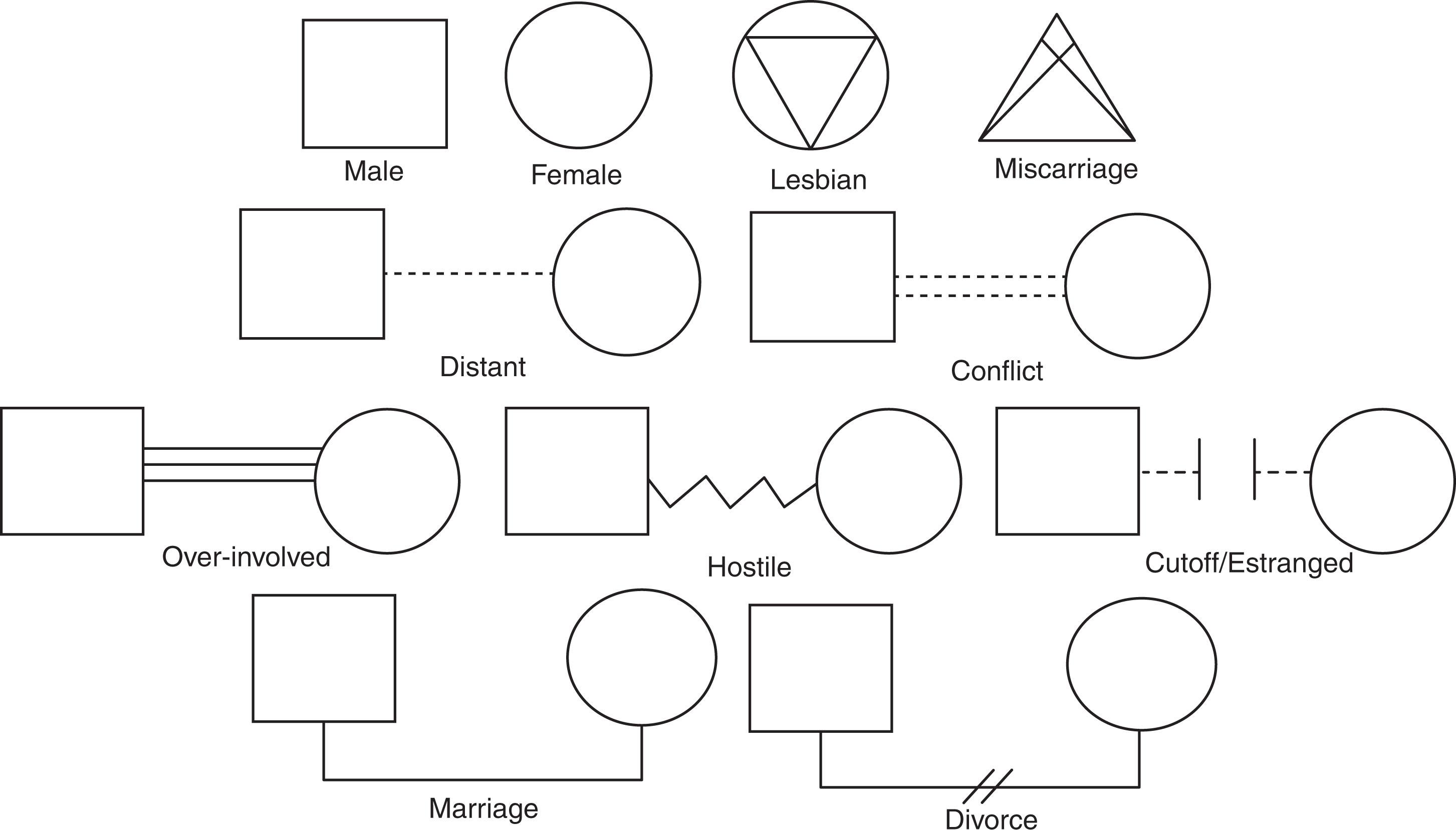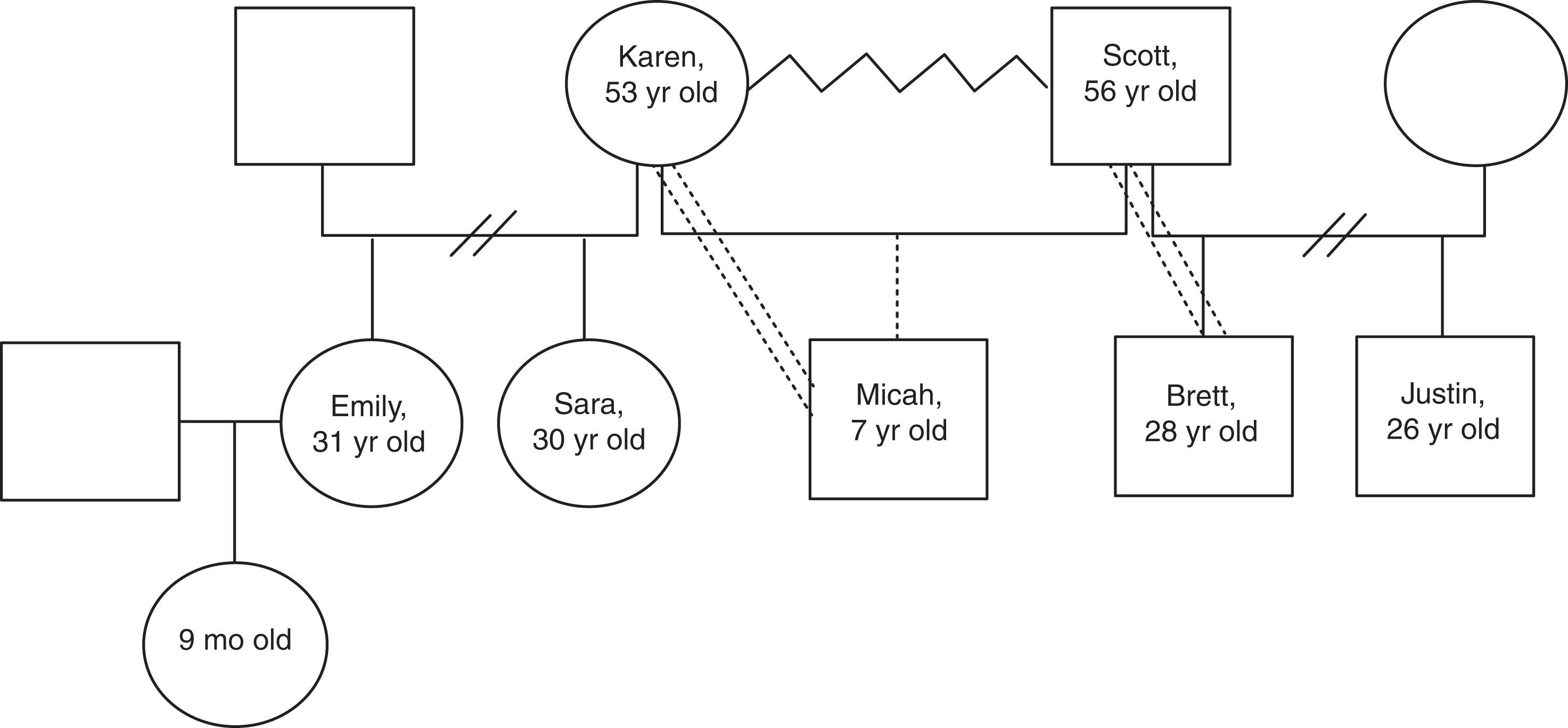Physical Address
304 North Cardinal St.
Dorchester Center, MA 02124
For additional material related to the content of this chapter, please see Chapter 10 , 13 , 81 , 97 , and 117 .
Karen and Scott married in their late 40 s, after each ended their first marriages. Both brought biological children to their blended family: Karen’s daughters (Emily and Sara) and Scott’s sons (Brett and Justin) all were older adolescents when they married. The transition to a blended family was difficult at first. Eventually the family adjusted to the change, settling into roles as stepparents and stepsiblings. Karen and Scott wanted their “own” children and began this journey by foster parenting .
After caring for numerous school-aged children, they were asked to foster a baby boy, Micah, who was born prematurely due to alcohol and substance exposure. Micah arrived at Karen and Scott’s home after spending 3 weeks in the neonatal intensive care unit (NICU). He was small, fussy, and had difficulty with feeding and sleeping. Despite these challenges, after months of fostering, Karen and Scott decided to legally adopt Micah .
Micah immediately received early intervention services due to his high risk of developmental delays. Even with these services, Karen and Scott noticed language delays and hyperactive behavior, and developmental testing revealed cognitive delays. Eventually, Micah was diagnosed with fetal alcohol spectrum disorder (FASD), language disorder, attention-deficit/hyperactivity disorder (ADHD), and intellectual disability (ID) .
Micah, now 7 years old, continues to experience communication deficits and extreme emotion and behavior regulation challenges. Karen describes Micah as quite volatile when he does not get his way or when requests are made of him. He destroyed property in the home, aggresses toward others (particularly Karen), disrobes, and intentionally urinates/defecates on floors. Karen admits that her limit-setting skills are not strong. Karen frequently relies on Scott when she can no longer manage Micah. Scott tells Karen how better to manage these challenging situations, but she perceives his advice as a criticism of her parenting. Micah’s siblings, especially Justin and Sara, often step in to provide respite for Karen and Scott. Recently Emily welcomed her own first child, and has had less involvement in Micah’s care. Karen regretfully admits that she wishes that she had never adopted Micah. Karen and Scott began couples therapy to repair their marriage, and a parenting behavioral intervention training program to increase their effectiveness with Micah and decrease the tensions in their family .
The construct of “family” has predictable features. The family itself has a developmental life cycle within which its members grow, it has a structure that defines relationships, it has a culture of its own, as well as the race and ethnicities of its members, and it has a process that organizes the functioning of family relationships. These features exist regardless of whether a family member’s development is neurotypical or not and are essential to fully understanding children with developmental and behavioral disabilities. This chapter aims to enhance child health clinicians’ understanding of child development and behavior from a family systems perspective with a focus on children with developmental and behavioral disabilities. The first half of the chapter serves as an overview of family systems theory, discusses the role of family in the context of development, and introduces the family life cycle. A case vignette is included to illustrate these family systems concepts. The second half of this chapter describes milestones in a family’s life cycle that are unique to developmental and behavioral disabilities. This section includes multiple case vignettes to demonstrate the diversity of families with developmental and behavioral disabilities over time. Each case vignette describes the family with a genogram ( Fig. 12.1 provides a key).

Families vary in many other ways, including their biologic connections, cohabitation, legal binds, and demographics. All these features have direct impact on its members, including their children with special needs. Taken broadly, family is a group of people connected and bonded either emotionally, biologically, or legally, usually with long-lasting and meaningful relationships ( ). In the United States today children live in a variety of family situations, including single parent, two-parent, blended, multifamily, and multigenerational family homes. Primary caregivers are parents (adopted or biological), stepparents, grandparents, older siblings, and/or extended family members and close family friends (also known as fictive family). Marital status, cohabitation, racial, gender, and sexual identities vary. Over time, families, have evolved to be more fluid and inclusive in their composition ( ).
Family systems theory states that all families are interconnected, intertwined, and dynamic ( ). Instead of viewing a family as individual members who determine their own course, a family systems lens views families as a unit with multiple interacting parts and recursive patterns of behaviors that reinforce functioning (adaptive or not) and create a homeostasis that perpetuates family dynamics until some significant force changes family functioning.
Clinicians who adopt a systemic lens move from thinking of family members as collateral reporters and implementers of treatment recommendations, to partners who understand the child’s health as intertwined in family health, behavior, resources, and supports. The Martins ( Fig. 12.2 ) illustrate some of the ways people form a new family. For Emily, Sara, Brett, Justin, and Micah, their sibship evolved as the result of divorce, marriage, and fostering to adoption. At each of these transitions, a family reorganizes to adjust to new roles and responsibilities, and settle into their cohesive family dynamic. When first blending families, Emily and Brett fought over the “oldest sibling” role, exposing Karen and Scott’s differences in parenting. With time, tensions settled, and Karen and Scott acclimated to their roles as parent, stepparent, and spouse. When Karen and Scott welcomed Micah as a foster child, Emily, Sara, Brett, and Justin were in high school and beginning the process of “leaving home.” Micah’s adoption replaced Justin as the “baby” of the family and shifted his role to include childcare responsibilities. Family systems theory recognizes the reality that Micah’s development will be influenced by the dynamics that evolved along with his blended family.

Family systems form a nest from which humans explore their world. According to the US Census Bureau, in 2019 approximately 73,525,000 children lived in family households. Of this group, 70% lived in two-parent homes (biological, stepparent, adoptive parents, and other partners) and 21% with single mothers. Ten percent of children live with at least one grandparent, 80% with siblings, and less than 1% in homes with only nonbiologically related individuals ( ). The importance of parents and other primary caregivers in children’s development is well documented. Less recognized, however, are the important roles that siblings, grandparents, extended family members, and family of choice also play in health and development ( Table 12.1 ).
| Family Member Role | Contributions to Psychological, Cognitive, Motor, and Social-Emotional Development |
|---|---|
| Parental figure |
|
| Grandparents |
|
| Siblings |
|
| Extended relatives and family of choice |
|
Parental figures (e.g., parents and other primary caregivers) are responsible for providing basic needs to children, including the food, shelter, safety, and protection that are integral for survival and development. Beyond these basic needs, parental figures are the formative base for attachment, emotional support, and emotional wellbeing in a child’s life ( ). They model language, social behavior, and emotion regulation in each interaction with their child. The quality and frequency of parent-child interactions stimulate brain development, scaffold new skills, set expectations for behaviors, and shape foundational understandings of social relationships ( ).
Parental figures are responsible for decisions related to health care and education. They may monitor and promote healthy preschool and school-age peer relationships, and they can provide opportunities for interaction with broader community resources, including connection to religious communities and extracurricular activities. In healthier family systems parent-child relationships create environments that promote the child’s successful physical, cognitive, and social/emotional development ( ). In less healthy systems parental figures can have lasting maladaptive influences on children’s growth ( ). For Micah, the attention and stimulation, health care access, and enrichment experiences Karen and Scott provided were especially critical when working with his developmental delays.
A parental figure’s approach to parenting is determined in part by their own experience as a child ( ) and often is delivered in collaboration (or conflict) with another parenting figure (see Chapter 13 ). The intergenerational transmission of parenting is well documented for both adaptive and harsh parenting practices. When two or more parental figures are involved, their branches of family influence can intertwine, so parenting styles may vary between parents. Parents ideally negotiate these disagreements. When this does not occur, they risk inconsistency, conflict, and confusion for their child. Parental figures receive input, both solicited and unsolicited, from grandparents, extended relatives, and close friends. All approaches are embedded within the context of the family’s culture. We return to our first case example to illustrate these points:
Karen and Scott come from different family backgrounds. Scott’s parenting borrows from his father’s military roots, and he is more controlling and rigid when disciplining his children. Karen’s parenting also mirrors her parents’ style, leaning toward permissive at times. When they started coparenting, these differences brought moments of conflict and tension and were confusing for their children. Their biggest differences were exposed during sibling conflict. Over time and with communication, Karen and Scott reconciled their parenting differences and established a collaborative approach, even when not seeing eye to eye. This was especially helpful to Justin, as he experimented with risky peers in adolescence and required more monitoring, discipline, and attention .
When parents are under duress, the foundation for their child’s development can be compromised, with consequences that can last generations ( ). While parental stress is normative, it can be amplified for parental figures of children with chronic illness or with developmental and behavioral disability. These caregivers can also experience stress related to their own mental or physical illness, problems in romantic relationships, domestic violence, coparenting after divorce, financial strain, discrimination, work stress, or problems in the extended family system. Parental stress can affect epigenetic markers during reproduction, prenatal development, and daily parent-child interactions ( ). Parental figures under considerable stress often have reduced capacity to respond to their child with emotional warmth and can be at higher risk for perpetrating physical or emotional abuse ( ). Even without the presence of physical violence, chronic marital discord and/or contentious divorce can create a family dynamic that loses focus on the role/responsibilities of parenting and instead centers on marital conflict and resentment. Children’s needs in these situations can become a currency for conflict instead of collaborative parenting. Similar issues arise if other family members have serious, ongoing conflict.
Clinicians who appreciate these family dynamics understand the importance of assessing family functioning as part of their regular care of children. For example, in addition to asking who lives in a child’s home, it is important to inquire about the quality of family members’ relationships, what stressors and supports a parental figure experiences, and how they approach parenting their child.
Become a Clinical Tree membership for Full access and enjoy Unlimited articles
If you are a member. Log in here